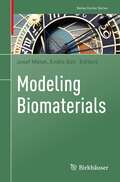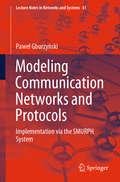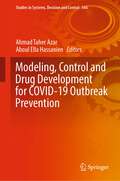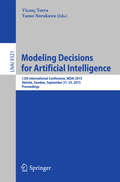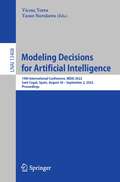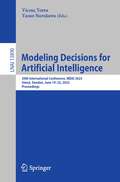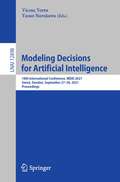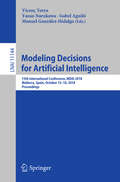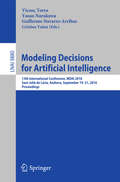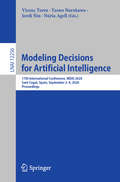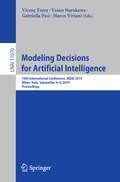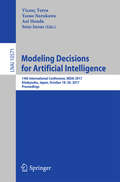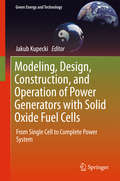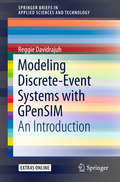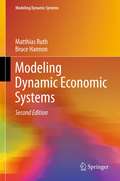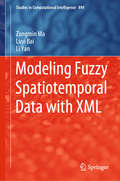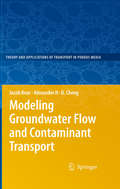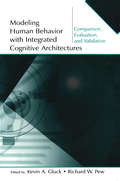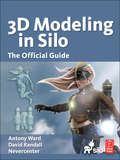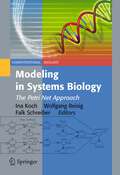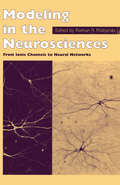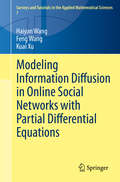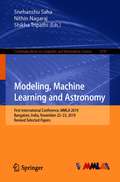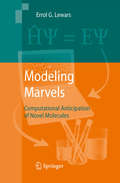- Table View
- List View
Modeling Biomaterials (Nečas Center Series)
by Josef Málek Endre SüliThe investigation of the role of mechanical and mechano-chemical interactions in cellular processes and tissue development is a rapidly growing research field in the life sciences and in biomedical engineering. Quantitative understanding of this important area in the study of biological systems requires the development of adequate mathematical models for the simulation of the evolution of these systems in space and time. Since expertise in various fields is necessary, this calls for a multidisciplinary approach.This edited volume connects basic physical, biological, and physiological concepts to methods for the mathematical modeling of various materials by pursuing a multiscale approach, from subcellular to organ and system level. Written by active researchers, each chapter provides a detailed introduction to a given field, illustrates various approaches to creating models, and explores recent advances and future research perspectives. Topics covered include molecular dynamics simulations of lipid membranes, phenomenological continuum mechanics of tissue growth, and translational cardiovascular modeling. Modeling Biomaterials will be a valuable resource for both non-specialists and experienced researchers from various domains of science, such as applied mathematics, biophysics, computational physiology, and medicine.
Modeling Communication Networks and Protocols: Implementation via the SMURPH System (Lecture Notes in Networks and Systems #61)
by Paweł GburzyńskiThis book provides an introduction to the software system SMURPH, comprising a programming language, its compiler, and an execution environment, for specifying communication networks and protocols and executing those specifications in virtual worlds mimicking the behavior of real-life implementations. It particularly focuses on SMURPH’s wireless modeling capabilities. Written in a manual-like fashion, it includes a comprehensive description of SMURPH functionality, as well as illustrations and case studies to aid understanding.
Modeling, Control and Drug Development for COVID-19 Outbreak Prevention (Studies in Systems, Decision and Control #366)
by Ahmad Taher Azar Aboul Ella HassanienThis book is well-structured book which consists of 31 full chapters. The book chapters' deal with the recent research problems in the areas of modeling, control and drug development, and it presents various techniques of COVID-19 outbreak prevention modeling. The book also concentrates on computational simulations that may help speed up the development of drugs to counter the novel coronavirus responsible for COVID-19.
Modeling Decisions for Artificial Intelligence
by Vicenç Torra Yasuo NarukawaThis book constitutes the proceedings of the 12th International Conference on Modeling Decisions for Artificial Intelligence, MDAI 2015, held in Skövde, Sweden, in September 2015. The 18 revised full papers presented were carefully reviewed and selected from 38 submissions. They discuss theory and tools for modeling decisions, as well as applications that encompass decision making processes and information fusion techniques.
Modeling Decisions for Artificial Intelligence: 19th International Conference, MDAI 2022, Sant Cugat, Spain, August 30 – September 2, 2022, Proceedings (Lecture Notes in Computer Science #13408)
by Vicenç Torra Yasuo NarukawaThis book constitutes the refereed proceedings of the 19th International Conference on Modeling Decisions for Artificial Intelligence, MDAI 2022, held in Sant Cugat, Spain, during August - September 2022.The 16 papers presented in this volume were carefully reviewed and selected from 41 submissions. The papers discuss different facets of decision processes in a broad sense and present research in data science, machine learning, data privacy, aggregation functions, human decision-making, graphs and social networks, and recommendation and search. They were organized in topical sections as follows: Decision making and uncertainty; Data privacy; Machine Learning and data science.
Modeling Decisions for Artificial Intelligence: 20th International Conference, MDAI 2023, Umeå, Sweden, June 19–22, 2023, Proceedings (Lecture Notes in Computer Science #13890)
by Vicenç Torra Yasuo NarukawaThis book constitutes the refereed proceedings of the 20th International Conference on Modeling Decisions for Artificial Intelligence, MDAI 2023, held in Umeå, Sweden, during June19–22,2023.The 17 papers presented in this volume were carefully reviewed and selected from 28 submissions. Additionally, 1 invited paper were included. The papers discuss different facets of decision processes in a broad sense and present research in data science, data privacy, aggregation functions, human decision making, graphs and social networks, and recommendation and search.The papers are organized in the following topical sections: Decision making and uncertainty; Machine Learning and data science; and Data privacy.
Modeling Decisions for Artificial Intelligence: 18th International Conference, MDAI 2021, Umeå, Sweden, September 27–30, 2021, Proceedings (Lecture Notes in Computer Science #12898)
by Vicenç Torra Yasuo NarukawaThis book constitutes the refereed proceedings of the 18th International Conference on Modeling Decisions for Artificial Intelligence, MDAI 2021, held in Umeå, Sweden, in September 2021.* The 24 papers presented in this volume were carefully reviewed and selected from 50 submissions. Additionally, 3 invited papers were included. The papers discuss different facets of decision processes in a broad sense and present research in data science, data privacy, aggregation functions, human decision making, graphs and social networks, and recommendation and search. The papers are organized in the following topical sections: aggregation operators and decision making; approximate reasoning; machine learning; data science and data privacy. *The conference was held virtually due to the COVID-19 pandemic.
Modeling Decisions for Artificial Intelligence: 15th International Conference, MDAI 2018, Mallorca, Spain, October 15–18, 2018, Proceedings (Lecture Notes in Computer Science #11144)
by Vicenç Torra Yasuo Narukawa Isabel Aguiló Manuel González-HidalgoThis book constitutes the proceedings of the 15th International Conference on Modeling Decisions for Artificial Intelligence, MDAI 2018, held in Mallorca, Spain, in October 2018.The 24 papers presented in this volume were carefully reviewed and selected from 43 submissions. The book also contains one invited talk in full paper length. The papers were organized in topical sections named: aggregation operators, fuzzy measures and integrals; decision making; clustering and classification; and data privacy and security.
Modeling Decisions for Artificial Intelligence
by Vicenç Torra Yasuo Narukawa Guillermo Navarro-Arribas Cristina YañezThis volume contains papers presented at the 2nd International Conference on Modeling Decisions for Arti?cial Intelligence (MDAI 2005), held in Tsukuba, Japan, July 25-27. This conference follows MDAI 2004 (held in Barcelona, Catalonia, Spain), the proceedings of which were also published in the LNAI series (Vol. 3131). The aim of this conference was to provide a forum for researchers to discuss about theory and tools for modeling decisions, as well as applications that - compass decision-making processes and information fusion techniques. In this second edition, special focus was given to applications related to risk, security and safety. The organizers received 118 papers, from 14 di?erent countries, 40 of which are published in this volume. Each submission received at least two reviews from the Program Committee and a few external reviewers. We would like to express our gratitude to them for their work. The plenary talks presented at the conference are also included in this volume. The conference was supported by the Department of Risk Engineering of the University of Tsukuba, the Japan Society for Fuzzy Theory and Intelligent Informatics (SOFT), the Catalan Association for Arti?cial Intelligence (ACIA), the European Society for Fuzzy Logic and Technology (EUSFLAT) and the Generalitat de Catalunya (AGAUR 2004XT 0004).
Modeling Decisions for Artificial Intelligence: 17th International Conference, MDAI 2020, Sant Cugat, Spain, September 2–4, 2020, Proceedings (Lecture Notes in Computer Science #12256)
by Vicenç Torra Yasuo Narukawa Jordi Nin Núria AgellThis book constitutes the refereed proceedings of the 17th International Conference on Modeling Decisions for Artificial Intelligence, MDAI 2020, held in Sant Cugat, Spain, in September 2020.* The 24 papers presented in this volume were carefully reviewed and selected from 46 submissions. They discuss different facets of decision processes in a broad sense and present research in data science, data privacy, aggregation functions, human decision making, graphs and social networks, and recommendation and search. The papers are organized in the following topical sections: aggregation operators and decision making, and data science and data mining. * The conference was canceled due to the COVID-19 pandemic.
Modeling Decisions for Artificial Intelligence: 16th International Conference, MDAI 2019, Milan, Italy, September 4–6, 2019, Proceedings (Lecture Notes in Computer Science #11676)
by Vicenç Torra Yasuo Narukawa Gabriella Pasi Marco VivianiThis book constitutes the refereed proceedings of the 16th International Conference on Modeling Decisions for Artificial Intelligence, MDAI 2019, held in Milan, Italy, in September 2019. The 30 papers presented in this volume were carefully reviewed and selected from 50 submissions. They discuss different facets of decision processes in a broad sense and present research in data science, data privacy, aggregation functions, human decision making, graphs and social networks, and recommendation and search. The papers are organized in the following topical sections: aggregation operators and decision making; data science and data mining; and data privacy and security.
Modeling Decisions for Artificial Intelligence: 14th International Conference, MDAI 2017, Kitakyushu, Japan, October 18-20, 2017, Proceedings (Lecture Notes in Computer Science #10571)
by Vicenç Torra, Yasuo Narukawa, Aoi Honda and Sozo InoueThis book constitutes the proceedings of the 14th International Conference on Modeling Decisions for Artificial Intelligence, MDAI 2017, held in Kitakyushu, Japan, in October 2017.The 18 revised full papers presented together with one invited paper and three abstracts of invited talks were carefully reviewed and selected from 30 submissions. Providing a forum for researchers to discuss models for decision and information fusion (aggregation operators) and their applications to AI, the papers are organized in topical sections on aggregation operators, fuzzy measures and integrals; clustering and classication; data privacy and security; data mining and applications.
Modeling, Design, Construction, and Operation of Power Generators with Solid Oxide Fuel Cells: From Single Cell To Complete Power System (Green Energy And Technology)
by Jakub KupeckiThe book summarizes the current state of the solid oxide fuel cell (SOFC) technology in power generation applications. It describes the single cells, SOFC stacks, micro-combined heat and power systems, large-scale stationary power generators and polygeneration units. The principles of modeling, simulation and controls of power systems with solid oxide fuel cells are presented and discussed. Authors provide theoretical background of the technology followed by the essential insights into the integrated power systems. Selected aspects of the design, construction and operation of power units in range from single kilowatts to hundreds of kilowatts are presented. Finally, the book reports the selected studies on prototype systems which have been constructed in Europe.The book discusses the theoretical and practical aspects of operation of power generators with solid oxide fuel cells including fabrication of cells, design of stacks, system modeling, simulation of stationary and non-stationary operation of systems, fuel preparation and controls.
Modeling Discrete-Event Systems with GPenSIM: An Introduction (SpringerBriefs in Applied Sciences and Technology)
by Reggie DavidrajuhModeling Discrete-Event Systems with GPenSIM describes the design and applications of General Purpose Petri Net Simulator (GPenSIM), which is a software tool for modeling, simulation, and performance analysis of discrete-event systems. The brief explains the principles of modelling discrete-event systems, as well as the design and applications of GPenSIM. It is based on the author’s lectures that were given on “modeling, simulation, and performance analysis of discrete event systems”. The brief uses GPenSIM to enable the efficient modeling of complex and large-scale discrete-event systems. GPenSIM, which is based on MATLAB®, is designed to allow easy integration of Petri net models with a vast number of toolboxes that are available on the MATLAB®. The book offers an approach for developing models that can interact with the external environment; this will help readers to solve problems in industrial diverse fields. These problems include:airport capacity evaluation for aviation authorities;finding bottlenecks in supply chains;scheduling drilling operations in the oil and gas industry; andoptimal scheduling of jobs in grid computing. This brief is of interest to researchers working on the modeling, simulation and performance evaluation of discrete-event systems, as it shows them the design and applications of an efficient modeling package. Since the book also explains the basic principles of modeling discrete-event systems in a step-by-step manner, it is also of interest to final-year undergraduate and postgraduate students.
Modeling Dynamic Economic Systems
by Bruce Hannon Matthias RuthThis book explores the dynamic processes in economic systems, concentrating on the extraction and use of the natural resources required to meet economic needs. Sections cover methods for dynamic modeling in economics, microeconomic models of firms, modeling optimal use of both nonrenewable and renewable resources, and chaos in economic models. This book does not require a substantial background in mathematics or computer science.
Modeling Fuzzy Spatiotemporal Data with XML (Studies in Computational Intelligence #894)
by Li Yan Zongmin Ma Luyi BaiThis book offers in-depth insights into the rapidly growing topic of technologies and approaches to modeling fuzzy spatiotemporal data with XML. The topics covered include representation of fuzzy spatiotemporal XML data, topological relationship determination for fuzzy spatiotemporal XML data, mapping between the fuzzy spatiotemporal relational database model and fuzzy spatiotemporal XML data model, and consistencies in fuzzy spatiotemporal XML data updating. Offering a comprehensive guide to the latest research on fuzzy spatiotemporal XML data management, the book is intended to provide state-of-the-art information for researchers, practitioners, and graduate students of Web intelligence, as well as data and knowledge engineering professionals confronted with non-traditional applications that make the use of conventional approaches difficult or impossible.
Modeling Groundwater Flow and Contaminant Transport
by Jacob Bear Alexander H.-D. ChengIn many parts of the world, groundwater resources are under increasing threat from growing demands, wasteful use, and contamination. To face the challenge, good planning and management practices are needed. A key to the management of groundwater is the ability to model the movement of fluids and contaminants in the subsurface. The purpose of this book is to construct conceptual and mathematical models that can provide the information required for making decisions associated with the management of groundwater resources, and the remediation of contaminated aquifers. The basic approach of this book is to accurately describe the underlying physics of groundwater flow and solute transport in heterogeneous porous media, starting at the microscopic level, and to rigorously derive their mathematical representation at the macroscopic levels. The well-posed, macroscopic mathematical models are formulated for saturated, single phase flow, as well as for unsaturated and multiphase flow, and for the transport of single and multiple chemical species. Numerical models are presented and computer codes are reviewed, as tools for solving the models. The problem of seawater intrusion into coastal aquifers is examined and modeled. The issues of uncertainty in model input data and output are addressed. The book concludes with a chapter on the management of groundwater resources. Although one of the main objectives of this book is to construct mathematical models, the amount of mathematics required is kept minimal.
Modeling Human Behavior With Integrated Cognitive Architectures: Comparison, Evaluation, and Validation
by Kevin A. Gluck Richard W. PewResulting from the need for greater realism in models of human and organizational behavior in military simulations, there has been increased interest in research on integrative models of human performance, both within the cognitive science community generally, and within the defense and aerospace industries in particular. This book documents accomplishments and lessons learned in a multi-year project to examine the ability of a range of integrated cognitive modeling architectures to explain and predict human behavior in a common task environment that requires multi-tasking and concept learning.This unique project, called the Agent-Based Modeling and Behavior Representation (AMBR) Model Comparison, involved a series of human performance model evaluations in which the processes and performance levels of computational cognitive models were compared to each other and to human operators performing the identical tasks. In addition to quantitative data comparing the performance of the models and real human performance, the book also presents a qualitatively oriented discussion of the practical and scientific considerations that arise in the course of attempting this kind of model development and validation effort.The primary audiences for this book are people in academia, industry, and the military who are interested in explaining and predicting complex human behavior using computational cognitive modeling approaches. The book should be of particular interest to individuals in any sector working in Psychology, Cognitive Science, Artificial Intelligence, Industrial Engineering, System Engineering, Human Factors, Ergonomics and Operations Research. Any technically or scientifically oriented professional or student should find the material fully accessible without extensive mathematical background.
Modeling in Event-B
by Jean-Raymond AbrialA practical text suitable for an introductory or advanced course in formal methods, this book presents a mathematical approach to modelling and designing systems using an extension of the B formal method: Event-B. Based on the idea of refinement, the author's systematic approach allows the user to construct models gradually and to facilitate a systematic reasoning method by means of proofs. Readers will learn how to build models of programs and, more generally, discrete systems, but this is all done with practice in mind. The numerous examples provided arise from various sources of computer system developments, including sequential programs, concurrent programs and electronic circuits. The book also contains a large number of exercises and projects ranging in difficulty. Each of the examples included in the book has been proved using the Rodin Platform tool set, which is available free for download at www. event-b. org.
Modeling in Silo: The Official Guide
by Antony Ward David Randall NevercenterCreate high-quality models in no time at all with these comprehensive, full-color, techniques and tutorials from Antony Ward and David Randall. These step-by-step tutorials walk readers through the creation of a high-quality female model while teaching you the basics and principles behind 3D modeling in Silo - including modeling the face and clothes, creating textures, and posing the character. The companion website includes all of the tutorial and project files. This book is officially endorsed and co-written by the creators of Silo, Nevercenter. Features include:
Modeling in Systems Biology
by Falk Schreiber Ina Koch Wolfgang ReisigThe emerging, multi-disciplinary field of systems biology is devoted to the study of the relationships between various parts of a biological system, and computer modeling plays a vital role in the drive to understand the processes of life from an holistic viewpoint. Advancements in experimental technologies in biology and medicine have generated an enormous amount of biological data on the dependencies and interactions of many different molecular cell processes, fueling the development of numerous computational methods for exploring this data. The mathematical formalism of Petri net theory is able to encompass many of these techniques. This essential text/reference presents a comprehensive overview of cutting-edge research in applications of Petri nets in systems biology, with contributions from an international selection of experts. Those unfamiliar with the field are also provided with a general introduction to systems biology, the foundations of biochemistry, and the basics of Petri net theory. Further chapters address Petri net modeling techniques for building and analyzing biological models, as well as network prediction approaches, before reviewing the applications to networks of different biological classification. Topics and features: investigates the modular, qualitative modeling of regulatory networks using Petri nets, and examines an Hybrid Functional Petri net simulation case study; contains a glossary of the concepts and notation used in the book, in addition to exercises at the end of each chapter; covers the topological analysis of metabolic and regulatory networks, the analysis of models of signaling networks, and the prediction of network structure; provides a biological case study on the conversion of logical networks into Petri nets; discusses discrete modeling, stochastic modeling, fuzzy modeling, dynamic pathway modeling, genetic regulatory network modeling, and quantitative analysis techniques; includes a Foreword by Professor Jens Reich, Professor of Bioinformatics at Humboldt University and Max Delbrück Center for Molecular Medicine in Berlin. This unique guide to the modeling of biochemical systems using Petri net concepts will be of real utility to researchers and students of computational biology, systems biology, bioinformatics, computer science, and biochemistry.
Modeling in the Neurosciences: From Ionic Channels to Neural Networks
by Roman R. PoznanskiWith contributions from more than 40 renowned experts, Modeling in the Neurosciences: From Ionic Channels to Neural Networks is essential for those interested in neuronal modeling and quantitative neiroscience. Focusing on new mathematical and computer models, techniques and methods, this monograph represents a cohesive and comprehensive treatment
Modeling Information Diffusion in Online Social Networks with Partial Differential Equations (Surveys and Tutorials in the Applied Mathematical Sciences #7)
by Feng Wang Haiyan Wang Kuai XuThe book lies at the interface of mathematics, social media analysis, and data science. Its authors aim to introduce a new dynamic modeling approach to the use of partial differential equations for describing information diffusion over online social networks. The eigenvalues and eigenvectors of the Laplacian matrix for the underlying social network are used to find communities (clusters) of online users. Once these clusters are embedded in a Euclidean space, the mathematical models, which are reaction-diffusion equations, are developed based on intuitive social distances between clusters within the Euclidean space. The models are validated with data from major social media such as Twitter. In addition, mathematical analysis of these models is applied, revealing insights into information flow on social media. Two applications with geocoded Twitter data are included in the book: one describing the social movement in Twitter during the Egyptian revolution in 2011 and another predicting influenza prevalence. The new approach advocates a paradigm shift for modeling information diffusion in online social networks and lays the theoretical groundwork for many spatio-temporal modeling problems in the big-data era.
Modeling, Machine Learning and Astronomy: First International Conference, MMLA 2019, Bangalore, India, November 22–23, 2019, Revised Selected Papers (Communications in Computer and Information Science #1290)
by Snehanshu Saha Nithin Nagaraj Shikha TripathiThis book constitutes the proceedings of the First International Conference on Modeling, Machine Learning and Astronomy, MMLA 2019, held in Bangalore, India, in November 2019.The 11 full papers and 3 short papers presented in this volume were carefully reviewed and selected from 63 submissions. They are organized in topical sections on modeling and foundations; machine learning applications; astronomy and astroinformatics.
Modeling Marvels
by Errol G. LewarsThe aim of this highly original book is to survey a number of chemical compounds that some chemists, theoretical and experimental, find fascinating. This is the first book to feature compounds/classes of compounds of theoretical interest that have been studied theoretically but have defied synthesis. It is hoped that this collection of idiosyncratic molecules will appeal to chemists who find the study of chemical oddities interesting and, on occasion, even rewarding.
